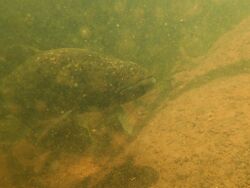Biology:Hoplias curupira
| Hoplias curupira | |
|---|---|

| |
| Scientific classification | |
| Domain: | Eukaryota |
| Kingdom: | Animalia |
| Phylum: | Chordata |
| Class: | Actinopterygii |
| Order: | Characiformes |
| Family: | Erythrinidae |
| Genus: | Hoplias |
| Species: | H. curupira
|
| Binomial name | |
| Hoplias curupira Oyakawa & Mattox, 2009[1]
| |
Hoplias curupira, also known as the black wolf-fish, has a wide distribution in the Amazon basin but was described as recently as 2009.
Taxonomy
Hoplias curupira was first formally described in 2009 by the Brazilian zoologists Osvaldo Takeshi Oyakawa & George Mendes Taliaferro Mattox with the type locality given as the Rio Itacaiúas, Caldeirão, Serra dos Carajás, Tocantins basin, Pará State in Brazil.[2] The fish is named after Curupira, a mythical creature of Brazilian folklore that protects the forest and its inhabitants, sometimes taking the form of a small Amerindian child whose feet are turned backwards, making it difficult to follow its tracks.[3]
Distribution
Hoplias curupira has an extensive distribution across the north of South America, Venezuela, Guyana, Surinam and Brazil in the Orinoco, Rio Negro (Amazon) and its tributaries, Rio Tocantins, Rio Xingu and Rio Negro (Amazon).[4]
Habitat
Hoplias curupire is found in large rivers and igarapés,[5] i.e. routes that are navigable by canoes.[6]
Description
Hoplias curupira are medium-sized but relatively bulky in build compared to other Hoplias with a blunt head and broad body. The colour of the fish changes according to mood from a light brown patterning to an almost solid black colouring leading to the common English name of Black Wolf-fish. In captivity the average size is 40 cm but wild specimens have been reported at up to 75 cm in length.[4]
Habits
Like other members of the genus Hoplias, H. curupira is an ambush predator on various insects, larvae, small fishes, shrimps, worms and fruits[5] and is more diurnal than its cogeners. They appear to live as pairs, defending a territory together.[7]
References
- ↑ Oyakawa, O. T.; Mattox, G. M. T. (2009). "Revision of the Neotropical trahiras of the Hoplias lacerdae species-group (Ostariophysi: Characiformes: Erythrinidae) with descriptions of two new species". Neotropical Ichthyology 7 (2): 117–140. doi:10.1590/S1679-62252009000200001. http://www.scielo.br/pdf/ni/v7n2/a01v7n2.pdf.
- ↑ Eschmeyer, William N.; Fricke, Ron; van der Laan, Richard, eds. "Species in the genus Hoplias". California Academy of Sciences. http://researcharchive.calacademy.org/research/ichthyology/catalog/fishcatget.asp?tbl=species&genus=Hoplias.
- ↑ "Order CHARACIFORMES: Families TARUMANIIDAE, ERYTHRINIDAE, PARODONTIDAE, CYNODONTIDAE, SERRASALMIDAE, HEMIODONTIDAE, ANOSTOMIDAE and CHILODONTIDAE". The ETYFish Project Fish Name Etymology Database. Christopher Scharpf and Kenneth J. Lazara. 22 September 2018. http://www.etyfish.org/characiformes2/.
- ↑ 4.0 4.1 "Hoplias Curupira - The Wolf Pack". Hoplias.webs.com. http://hoplias.webs.com/hopliascurupira.htm.
- ↑ 5.0 5.1 Froese, Rainer and Pauly, Daniel, eds. (2022). "Hplias curupira" in FishBase. February 2022 version.
- ↑ "Definition of 'igarapé'". Collins Dictionary. https://www.collinsdictionary.com/dictionary/english/igarape.
- ↑ http://thewebsiteofeverything.com/animals/fish/Characiformes/Erythrinidae/Hoplias-curupira
Wikidata ☰ Q6421504 entry
 |

